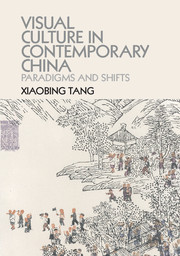Book contents
- Frontmatter
- Contents
- Acknowledgments
- A brief timeline of relevant events
- Introduction Toward a short history of visual culture in contemporary China
- Chapter 1 How was socialist visual culture created?
- Chapter 2 How was socialist visual culture created?
- Chapter 3 What do we see in New China cinema?
- Chapter 4 What does socialist visual experience mean to contemporary art?
- Chapter 5 How (not) to watch a Chinese blockbuster
- Chapter 6 Where to look for art in contemporary China
- Conclusion Seeing China from afar
- Glossary
- List of Illustrations
- Filmography
- Select bibliography
- Index
- References
Chapter 6 - Where to look for art in contemporary China
Published online by Cambridge University Press: 05 January 2015
- Frontmatter
- Contents
- Acknowledgments
- A brief timeline of relevant events
- Introduction Toward a short history of visual culture in contemporary China
- Chapter 1 How was socialist visual culture created?
- Chapter 2 How was socialist visual culture created?
- Chapter 3 What do we see in New China cinema?
- Chapter 4 What does socialist visual experience mean to contemporary art?
- Chapter 5 How (not) to watch a Chinese blockbuster
- Chapter 6 Where to look for art in contemporary China
- Conclusion Seeing China from afar
- Glossary
- List of Illustrations
- Filmography
- Select bibliography
- Index
- References
Summary
In March 2012, the European Fine Art Foundation (TEFAF), an organization based in the Netherlands that claims to host the world’s leading art fair annually in the city of Maastricht, reported that China had overtaken the United States in the previous year as the world’s largest market for art and antiques. The report surveyed the global art trade over the past twenty-five years and observed that, after surpassing the United Kingdom in 2010, in 2011 China had a 30 percent share of the world art market and edged out the United States by one percentage point. Dr. Clare McAndrew, a cultural economist and author of the commissioned report, described the development as “perhaps one of the most fundamental and important changes in the last 50 years,” providing yet another indicator of the “seismic shifts in the wider global economy.”
According to the TEFAF report, the global art market continued to recover from the recent economic crisis, with the total volume of transactions reaching $60.84 billion in 2011. The driving forces behind the recovery were the strong performance of the Chinese auction market and the rise of sales in fine art. The fine art market in China, in turn, was dominated by the sectors of modern and contemporary art, which accounted for nearly 70 percent of all sales. The explosive development of the Chinese art market, explained McAndrew, “has been driven by expanding wealth, strong domestic supply and the investive drive of Chinese art buyers.” More specifically, “growing domestic difficulties in Chinese property and stock markets and the lack of other alternatives appear to have led to a significant amount of substitution into art as an investment by Chinese consumers.”
- Type
- Chapter
- Information
- Visual Culture in Contemporary ChinaParadigms and Shifts, pp. 210 - 249Publisher: Cambridge University PressPrint publication year: 2015



